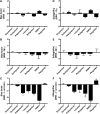Bias analyses of preclinical and clinical D2 dopamine ligands: studies with immediate and complex signaling pathways
- PMID: 25539635
- PMCID: PMC4352597
- DOI: 10.1124/jpet.114.220293
Bias analyses of preclinical and clinical D2 dopamine ligands: studies with immediate and complex signaling pathways
Abstract
G protein-coupled receptors (GPCRs) often activate multiple signaling pathways, and ligands may evoke functional responses through individual pathways. These unique responses provide opportunities for biased or functionally selective ligands to preferentially modulate one signaling pathway over another. Studies with several GPCRs have suggested that selective activation of signaling pathways downstream of a GPCR may lead to safer and more effective drug therapies. The dopamine D2 receptor (D2R) is one of the main drug targets in the therapies for Parkinson's disease and schizophrenia. Recent studies suggest that selective modulation of individual signaling pathways downstream of the D2R may lead to safer antipsychotic drugs. In the present study, immediate effectors of the D2R (i.e., Gαi/o, Gβγ, β-arrestin recruitment) and more complex signaling pathways (i.e., extracellular signal-regulated kinase phosphorylation, heterologous sensitization, and dynamic mass redistribution) were examined in response to a series of D2R ligands. This was accomplished using Chinese hamster ovary cells stably expressing the human D2L dopamine receptor in the PathHunter β-Arrestin GPCR Assay Platform. The use of a uniform cellular background was designed to eliminate potential confounds associated with cell-to-cell variability, including expression levels of receptor as well as other components of signal transduction, including G protein subunits. Several well characterized and clinically relevant D2R ligands were evaluated across each signaling pathway in this cellular model. The most commonly used methods to measure ligand bias were compared. Functional selectivity analyses were also used as tools to explore the relative contribution of immediate D2R effectors for the activation of more complex signaling pathways.
Copyright © 2015 by The American Society for Pharmacology and Experimental Therapeutics.
Figures







References
-
- Beaulieu JM, Gainetdinov RR. (2011) The physiology, signaling, and pharmacology of dopamine receptors. Pharmacol Rev 63:182–217. - PubMed
-
- Black JW, Leff P. (1983) Operational models of pharmacological agonism. Proc R Soc Lond B Biol Sci 220:141–162. - PubMed
-
- Bohn LM, Dykstra LA, Lefkowitz RJ, Caron MG, Barak LS. (2004) Relative opioid efficacy is determined by the complements of the G protein-coupled receptor desensitization machinery. Mol Pharmacol 66:106–112. - PubMed
-
- Bohn LM, Gainetdinov RR, Lin FT, Lefkowitz RJ, Caron MG. (2000) Mu-opioid receptor desensitization by beta-arrestin-2 determines morphine tolerance but not dependence. Nature 408:720–723. - PubMed
Publication types
MeSH terms
Substances
Grants and funding
LinkOut - more resources
Full Text Sources
Other Literature Sources

